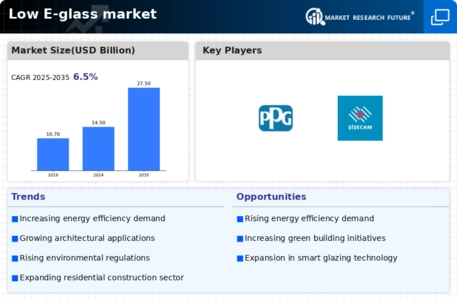Market Share
Low E Glass Market Share Analysis
The Low E Glass Market is witnessing strategic shifts as companies aim to establish a prominent presence in the energy-efficient glass sector. To gain a competitive edge, businesses are implementing various market positioning strategies that encompass technological innovation, customization, and sustainability. Here are key strategies employed in the market share positioning of Low E Glass: Advancements in Coating Technologies: Leading companies in the Low E Glass Market prioritize continuous advancements in coating technologies. This involves the development of high-performance low emissivity (Low E) coatings with enhanced thermal insulation properties, UV protection, and optical clarity. Innovations in coating technologies contribute to the introduction of energy-efficient glass products that meet the evolving demands of the construction and automotive industries, positioning manufacturers as leaders in the field. Diversification Across Applications: To broaden market reach, companies focus on diversifying the applications of Low E Glass. This includes its use in windows, doors, facades, and automotive glazing. Diversification allows companies to cater to the varied needs of different industries, positioning Low E Glass as a versatile solution for energy efficiency. Customization for Climate Requirements: Customization is a key strategy, with companies tailoring Low E Glass products for specific climate conditions. Offering variations that address different climate requirements enhances the appeal of these glasses for both residential and commercial construction projects in diverse geographical locations. Providing customized solutions improves the suitability of Low E Glass for varying energy efficiency needs, making it an attractive option for a wide range of customers. Sustainability and Environmental Considerations: With an increasing focus on sustainability, companies in the Low E Glass Market are adopting eco-friendly practices. This includes the use of low-emission coatings that reduce energy consumption in buildings, contributing to sustainability goals. Positioning Low E Glass as an environmentally conscious choice aligns with global green building standards and attracts environmentally conscious customers. Strategic Alliances with Architects and Designers: Collaborative efforts with architects, designers, and construction professionals form a strategic approach. Partnerships enable companies to work closely with industry stakeholders, providing insights into design trends, ensuring the integration of Low E Glass into architectural projects, and enhancing the aesthetic appeal of energy-efficient glass solutions. Joint ventures and collaborations with key influencers in the construction and design sectors strengthen a company's positioning in the market. Global Market Expansion: Companies aiming for increased market share strategically expand their global presence. This involves entering new markets, establishing partnerships with distributors, and adapting Low E Glass products to meet diverse international standards. A global footprint not only widens the customer base but also positions a company as a reliable supplier capable of meeting the diverse needs of an international clientele. Investment in Research and Development: A commitment to research and development is crucial for staying competitive in the Low E Glass Market. Companies invest in R&D to explore new coating formulations, improve manufacturing processes, and stay ahead of industry trends. Innovations stemming from R&D efforts contribute to positioning manufacturers as leaders in the development of cutting-edge energy-efficient glass solutions. Education and Awareness Programs: Providing education and awareness programs about the benefits of Low E Glass is a strategic approach. This includes educating architects, builders, and consumers about the energy-saving properties, cost-effectiveness, and long-term advantages of using Low E Glass in construction projects. Educated stakeholders are more likely to consider and specify Low E Glass, contributing to increased market adoption and positioning these products as essential components in energy-efficient building design.


 Source: Primary Research, Secondary Research, Market Research Future Database and Analyst Review
Source: Primary Research, Secondary Research, Market Research Future Database and Analyst Review


Leave a Comment